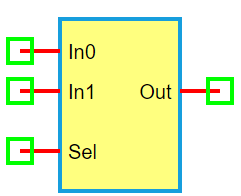2-to-1 Multiplexer
Information

A 2-to-1 multiplexer (MUX) is a digital circuit that selects one of two input signals and forwards it to the output based on a single select signal (Sel). It acts as a data selector.
If Sel = 0, the output is In0; If Sel = 1, the output is In1.
Truth table for 2-to-1 MUX:
Sel |
In0 |
In1 |
Out |
|---|---|---|---|
0 |
0 |
X |
0 |
0 |
1 |
X |
1 |
1 |
X |
0 |
0 |
1 |
X |
1 |
1 |
Ports
In0: First data input
In1: Second data input
Sel: Select signal
Out: Output signal
Model
The MUX2to1 model implements a 2-input, 1-select digital multiplexer.
Attributes:
In0 (dsignal): Input 0
In1 (dsignal): Input 1
Sel (dsignal): Select line
Out (dsignal): Output signal
Methods:
digital(): Outputs In0 if Sel is 0, otherwise In1:
\[\text{Out} = (\lnot Sel \land In0) \lor (Sel \land In1)\]
from pyams.lib import dsignal, model
class MUX2to1(model):
""" 2-to-1 Multiplexer """
def __init__(self, In0, In1, Sel, Out):
self.In0 = dsignal(direction='in', port=In0)
self.In1 = dsignal(direction='in', port=In1)
self.Sel = dsignal(direction='in', port=Sel)
self.Out = dsignal(direction='out', port=Out)
def digital(self):
""" Perform MUX logic """
self.Out += (~self.Sel & self.In0) | (self.Sel & self.In1)
Command syntax
The syntax for defining a 2-to-1 multiplexer in a PyAMS simulation:
# Import the model
from pyams.models import MUX2to1
# MUX: instance name
# In0, In1: data inputs; Sel: select; Out: output
MUX = MUX2to1(In0, In1, Sel, Out)